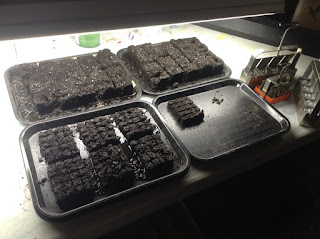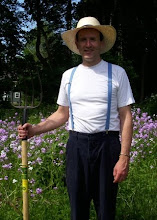OK, I finally started something this year. Hopefully, this will inspire me to do more. Yesterday, I placed some pea seeds in a jar and covered them with water. Today I emptied the water and when the seeds sprout, I will place them in soil blocks or containers. I have decided that I am going to always start plants inside because I have had so many experiences of young seedlings being devoured by slugs and other critters when they are started directly in the garden. It seems that once the plants have a couple of sets of leaves, they are much less vulnerable. Also, this allows me to make maximum use of available space when I do plant.

Look at the lettuce and parsley that overwintered! Granted it was a mild winter, but we still had temperatures into the single digits that devastated the lettuce that remained in another garden frame with only one layer of plastic. The second photo shows a frame with lettuce, onion, choi and parsley that overwintered. It won't be long before we are picking for salads again.

I gained a new appreciation for the compost towers as I was picking small weeds and leftover roots and debris from the garden beds. It was great to have a practical place to put the weeds because of the precious soil that was clinging to their roots. Now that soil will be reintroduced to the garden by earthworms after the weeds have been thoroughly composted. The compost tower solves another problem that I have been pondering, how to efficiently process the mats that are leftover from growing sprouts in soil trays? I had been contemplating trying vermiculture (composting with worms) in the kitchen, but I didn't like the idea of having another living environment/organism to carefully manage because I am already spread so thin. While I was throwing weeds in the compost tower, I realized that I already have vermiculture and that it is self managing!


On a sidenote, I am trying to start some sourdough starter because we have been baking every week and my wife wants us to eat as naturally as possible. There does seem to be a good argument for using sourdough starter instead of yeast (related to breakdown of phytic acid). I have found many methods described online that seem like too much work and waste of flour. Based on my research, I am trying what may be a novel method. I am cultivating yeast in a jar in the refrigerator filled with 1/4 cup of water, 1/4 cup of freshly ground whole-wheat flour (we have a grain mill), 1 teaspoon of zante currants (small raisins), and 1 teaspoon of live culture yogurt. I have been stirring it twice a day. Once I start seeing some bubbles, I will cut the mixture (in the process excluding the raisins) and add more flour and water. Once the yeast is established, I plan to take it out the day before baking to warm it up to room temperature and feed it. Hopefully, I will be able to get by with only feeding it once a week the day before baking time. I plan to try using 1 cup of starter for 4-5 cups of flour. The bread that we make (multi-grain boule) already has a 12 hour first rise, it will be interesting to see how much longer it will take, if any, with sourdough.
Crocuses have been blooming for about a week and leaf buds are becoming visible on the forsythia, lilacs and other trees. Robins have returned.

















